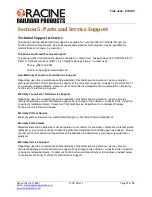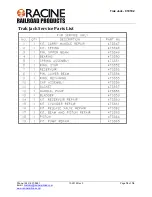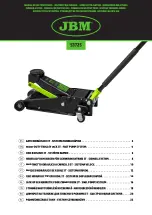
Trak Jack - 910192
Phone: (262) 637-9681
10.2019 Rev 3
Page
14
of
18
Section 4: Maintenance
It is highly recommended to practice regular check-ups and maintenance in accordance with the usage
frequency to keep your tool in better condition and reduces total running costs.
General
Store the Trak Jack in an upright position, in a place where it is protected from the elements, abrasive
dust, and damage.
Use only recommended repair and replacement parts and materials.
Do not use the jack for applications it was not designed for.
Use the carrying handle to transport the Trak Jack from location to location. Do not carry the Trak
Jack by inserting the jack handle in the socket.
Cleaning
Establish a routine to keep the jack as free from dirt.
Jacks exposed to rain, sand, or grit- laden air should be cleaned prior to each use.
Exposed screw threads should be cleaned and re-lubricated as necessary.
Keep the cylinder clean at all times. Keep the piston retracted when not in use.
Operating lever and load-bearing surfaces should be free of slippery material or fluids.
Keep tool labels and stickers legible.
Hydraulic Fluid
The Trak Jack holds approximately 28 ounces / 820 cc cubic inches of hydraulic fluid in its reservoir
A jack that is low on hydraulic fluid can lift a full load, but not to the full lift height. As the reservoir
begins to run dry, the lever socket becomes very easy to pump, and the jack stops lifting. To add oil:
1. Fully retract the plunger.
2. Remove the fill plug.
3. Fill the reservoir with new, clean fluid (use ISO # l5 Hydraulic Fluid) to a level 1/8 inch below the
bottom of the fill plug hole.
Do not use brake fluid or other non-approved substitute fluids.
Lighter weight fluids may cause the jack to fail under load.
Do not overfill or under fill the reservoir as this may damage the hydraulic jack
Note
: If the fluid level is correct, the pump handle will become almost impossible to pump by hand
as the piston reaches full extension and maximum hydraulic pressure































